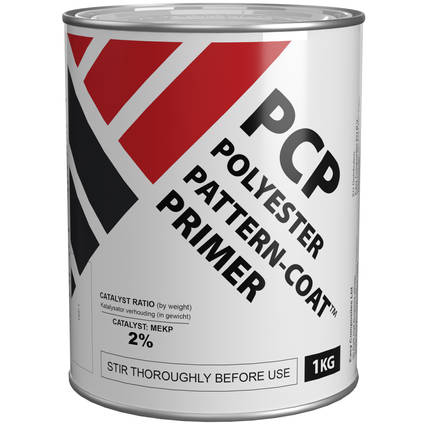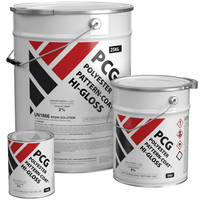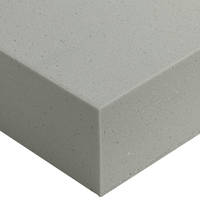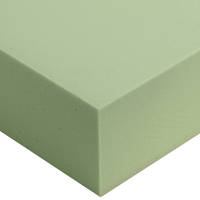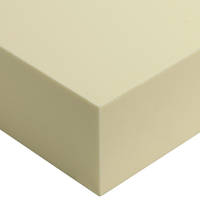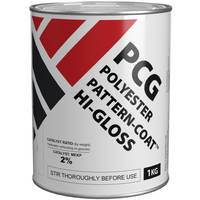Need any help or advice?+44 (0)1782 454499
Downloads (3)
This is a chemical product. Before storage or use you must download and read the accompanying safety and technical datasheets.
| Safety Datasheet (SDS) - EN | ||
| Safety Datasheet (SDS) - NL | ||
| Technical Datasheet (TDS) |
Specification
Product Data
| Colour | Grey | |
|---|---|---|
| Chemistry / Material | Polyester | |
| Viscosity | 15000 | mPa.s |
| Shelf Life | 3 | Months |
Cured Mechanical Properties
| Max Service Temp | 60 | °C |
|---|---|---|
| Tg Onset (DMA) | 60 | °C |
Pot Life and Cure Times
| Pot Life (Typical) | 15 | mins |
|---|---|---|
| Initial Cure Time | 12 | Hrs |
General Properties
| Gross Weight | 1.299 | kg |
|---|
Shipping Information
Restrictions
This product is classed as dangerous goods for transport.
It can be shipped to all mainland EU countries, Ireland, Balearic Islands, Corsica, Sicily and Sardinia.
Unfortunately, for the time being we are unable to ship dangerous goods to Cyprus, Malta, the Canary Islands, Ceuta, Melilla, Jan Mayan and Svalbard.
For a full information regarding the shipment of dangerous goods, see our delivery information page.
Package Size
There are no package size restrictions or surcharges for this product.
Delivery Cost
To find the delivery cost of this item to your address, add it to your basket and then use the instant shipping calculator on the basket page.
PCP Polyester Pattern-Coat Primer
- PCP-1
Hazardous
- 5/5 Average rating
PCP Polyester Pattern Coat Primer is a fast-curing, high-build, sandable polyester resin developed specifically for coating and finishing composite patterns. It can be applied by brush or sprayed onto composite patterns made from materials like foam, MDF, fibreglass, bodyfiller etc., to give them a smooth, high quality finish prior to taking a mould from.
Requires MEKP catalyst, not included. Available to buy online in 1kg and 5kg tins.
PRODUCT VERSIONS
Pack Size
AVAILABILITY:4 in stock available for immediate shipping
Optional items
PRODUCT OPTIONSWe won’t be beaten on price!
If you believe you’re buying an equivalent product cheaper elsewhere, contact us to discuss your requirements.
Requires MEKP Catalyst, not included.
Easy Composites' PCP Polyester Pattern-Coat™ Primer is a specially formulated high-build polyester resin system designed for the fast and easy surfacing of composite patterns. The composite pattern coating resin Primer will not sag or run off the vertical sides of patterns up to a 1.5mm thick application making light work of pattern surfacing.
PCP Polyester Pattern-Coat™ Primer can be used on its own as a fast-building, easy-to-sand and adequately glossy pattern surface, ready to take moulds straight off, or in conjunction with PCG Polyester Pattern-Coat™ Hi-Gloss when a very high gloss is required.
Further Information
Directions for Use
PCP Polyester Pattern-Coat™ Primer can be applied directly to polyurethane foam, modelboard, tooling block, MDF, wood, metal and some plastics. PCP Polyester Pattern-Coat™ Primer can be applied over patterns that have been filled with polyester bodyfiller however it should not be applied to expanded polystyrene foam (Styrofoam) because it will react and dissolve the foam.
Patterns made from very low density foams (anything less than around 40kgs/m3) should be 'scrimmed' with a layer of polyester resin reinforced with a lightweight glass cloth before application of the PCP Polyester Pattern-Coat™ Primer.
- To ensure a good bond, key the surface of the pattern using 80grit abrasive paper and remove any dirt or grease using acetone.
- PCP Polyester Pattern-Coat™ Primer should be mixed with MEKP Catalyst at a ratio of 2% catalyst (can be adjusted according to pot-life required and ambient temperature).
- Apply directly to the surface of the pattern by brush. Application by gelcoat spray gun will yield even better results (if using a nozzle smaller than 2.5mm, thin using 25% pure acetone).
Pigmented Guide-Coats
When sanding a coated pattern it is very useful to know how far through the pattern coat you have sanded so as to avoid breaking through the coating and through to the pattern material (such as foam) underneath. To help with this we recommend applying the PCP Polyester Pattern-Coat™ Primer in two layers, the first as supplied and the second layer with the addition of a 'guide coat' pigment, mixed into the Primer.
To do this, apply the first layer of PCP Polyester Pattern-Coat™ Primer as described above (either by brush or spray gun) and allow to cure to a 'B-Stage' where it is firm but still slightly tacky, before mixing pigment in with a second batch of PCP Polyester Pattern-Coat™ Primer and applying as above. This will not only result in a thicker application of Primer (allowing plenty of material to flat down through) but it will also alert you when you are down through the first layer of Primer and into the second layer meaning you can choose to stop and apply an additonal layer of Primer if you choose or avoid breaking through in thinner areas.
Flatting
Once cured (around 3hours, depending on ambient temperature) it can be wet-sanded and flatted using 120 then 240grit abrasive papers to start to develop the smooth accurate lines of the pattern. If necessary additional coats of the Primer can be applied and then flatted back until satisfactory.
Using without PCG Polyester Pattern-Coat™ Hi-Gloss
Where only a reasonable level of gloss on the pattern is acceptable then PCP Polyester Pattern-Coat™ Primer can be flatted and polished up to a smooth, medium gloss finish on its own.
- Wet-sand using increasingly fine abrasive papers (240, 400, 800, 1200) remembering to change the water when you change grits.
- Wait for the PCP Polyester Pattern-Coat™ Primer to cure fully (around 25hrs) before polishing using a power polisher.
- PCP Polyester Pattern-Coat™ Primer can be finished to a reasonable level of gloss using a polishing compound such as NW1 White Super Cutting Compound .
- Following the application of a suitable release agent (such as Wax, PVA or Chemical Release Agent) moulds can be taken directly from the Pattern-Coat™ Primer finish.
Using with PCG Polyester Pattern-Coat™ Hi-Gloss
Where a high level of gloss or harder surface is required on the pattern then we recommend finishing the PCP Polyester Pattern-Coat™ Primer to around a 120grit abrasive paper and then coating with PCG Polyester Pattern-Coat™ Hi-Gloss before flatting and polishing to a very high gloss finish.
Shelf Life and Storage
PCP Polyester Pattern‐Coat™ Primer should be stored in the dark in suitable closed containers. It is recommended that the storage temperature should be less than 20°C where practical, but it should not exceed 30°C. KEEP THE PACKING TIGHTLY SEALED WHEN NOT IN USE.
If stored under the above conditions the PCP Polyester Pattern‐Coat™ Primer will have a shelf life of 3 months, from the date of production.
Compatibility Information - Dos and Don'ts
Although by no means an exhaustive list, the pattern materials, pigments and additives listed below have all been tested and are known to work well with Pattern-Coat™ Primer.
Compatible Moulds
- Polyurethane foam
- Polyurethane Model Board
- Wood and MDF
- Polyester & epoxy based patterns after a good surface key
- 3D printed plastics such as PLA & Nylon (except ABS)
Compatible Pigments
- Polyester Colour Pigment * (for vivid opaque colours)
- Translucent Tinting Pigment * (for less vivid opaque colours)
Compatible Fillers
- All dry filler powders**
* Generally pigments are only used with the Pattern Coat System to help differentiate between layers of material when sanding.
** Although technically compatible, very few occasions would warrant the use of filler powders with a Pattern Coat System. PCP Polyester Pattern-Coat™ Primer is already heavily filled to aid application and sanding of the product.
Key Processing Information
- Ease of Use: Suitable for professional and hobby use (follow SDS advice).
- Odour: PCP Polyester Pattern Coat™ Primer has a strong styrene based odour.
- Safety Precautions: Wear gloves and goggles and work in a well ventilated area. Always read the SDS before use.
- Ambient Conditions: Can be used from 15 to 30°C although pot-life and cure time will be affected significantly. Recommended working at an ambient of 20-25°C.
- Degassing: Not necessary in most cases. Simply mix and use.
- Mix Ratio: Add MEKP Catalyst at a ratio of 2%. Use digital scales.
- Shelf Life: The resin and hardener has a shelf life of 3 months from the date of production.
- Mixing: Mix thoroughly by hand for at around 2 minutes.
- Application: Can be applied by spray gun or by brush. Maximum thickness per layer 1.5mm.
- Pot-Life: The pot life at 25°C is 15 minutes. When sprayed diluted with acetone as per TDS, pot-life is extended to 30 minutes. Be sure to use your resin before this time.
- Exotherm (Over-Heating): Resin will heat-up whilst it cures. Mix in small batches and use expediently. Mixed resin in a pot will quickly overheat (exotherm) and can smoke/ignite. Never leave mixed resin unattended.
- Cure Time/Overcoating: At 25°C you can expect the Primer to be ready for overcoats after 2-3 hours when at the firm but tacky stage of cure. The Primer will be ready for sanding after 12 hours and should be allowed 24 hours before machine polishing.
Requires MEKP Catalyst, not included.
Easy Composites' PCP Polyester Pattern-Coat™ Primer is a specially formulated high-build polyester resin system designed for the fast and easy surfacing of composite patterns. The composite pattern coating resin Primer will not sag or run off the vertical sides of patterns up to a 1.5mm thick application making light work of pattern surfacing.
PCP Polyester Pattern-Coat™ Primer can be used on its own as a fast-building, easy-to-sand and adequately glossy pattern surface, ready to take moulds straight off, or in conjunction with PCG Polyester Pattern-Coat™ Hi-Gloss when a very high gloss is required.
Further Information
Directions for Use
PCP Polyester Pattern-Coat™ Primer can be applied directly to polyurethane foam, modelboard, tooling block, MDF, wood, metal and some plastics. PCP Polyester Pattern-Coat™ Primer can be applied over patterns that have been filled with polyester bodyfiller however it should not be applied to expanded polystyrene foam (Styrofoam) because it will react and dissolve the foam.
Patterns made from very low density foams (anything less than around 40kgs/m3) should be 'scrimmed' with a layer of polyester resin reinforced with a lightweight glass cloth before application of the PCP Polyester Pattern-Coat™ Primer.
- To ensure a good bond, key the surface of the pattern using 80grit abrasive paper and remove any dirt or grease using acetone.
- PCP Polyester Pattern-Coat™ Primer should be mixed with MEKP Catalyst at a ratio of 2% catalyst (can be adjusted according to pot-life required and ambient temperature).
- Apply directly to the surface of the pattern by brush. Application by gelcoat spray gun will yield even better results (if using a nozzle smaller than 2.5mm, thin using 25% pure acetone).
Pigmented Guide-Coats
When sanding a coated pattern it is very useful to know how far through the pattern coat you have sanded so as to avoid breaking through the coating and through to the pattern material (such as foam) underneath. To help with this we recommend applying the PCP Polyester Pattern-Coat™ Primer in two layers, the first as supplied and the second layer with the addition of a 'guide coat' pigment, mixed into the Primer.
To do this, apply the first layer of PCP Polyester Pattern-Coat™ Primer as described above (either by brush or spray gun) and allow to cure to a 'B-Stage' where it is firm but still slightly tacky, before mixing pigment in with a second batch of PCP Polyester Pattern-Coat™ Primer and applying as above. This will not only result in a thicker application of Primer (allowing plenty of material to flat down through) but it will also alert you when you are down through the first layer of Primer and into the second layer meaning you can choose to stop and apply an additonal layer of Primer if you choose or avoid breaking through in thinner areas.
Flatting
Once cured (around 3hours, depending on ambient temperature) it can be wet-sanded and flatted using 120 then 240grit abrasive papers to start to develop the smooth accurate lines of the pattern. If necessary additional coats of the Primer can be applied and then flatted back until satisfactory.
Using without PCG Polyester Pattern-Coat™ Hi-Gloss
Where only a reasonable level of gloss on the pattern is acceptable then PCP Polyester Pattern-Coat™ Primer can be flatted and polished up to a smooth, medium gloss finish on its own.
- Wet-sand using increasingly fine abrasive papers (240, 400, 800, 1200) remembering to change the water when you change grits.
- Wait for the PCP Polyester Pattern-Coat™ Primer to cure fully (around 25hrs) before polishing using a power polisher.
- PCP Polyester Pattern-Coat™ Primer can be finished to a reasonable level of gloss using a polishing compound such as NW1 White Super Cutting Compound .
- Following the application of a suitable release agent (such as Wax, PVA or Chemical Release Agent) moulds can be taken directly from the Pattern-Coat™ Primer finish.
Using with PCG Polyester Pattern-Coat™ Hi-Gloss
Where a high level of gloss or harder surface is required on the pattern then we recommend finishing the PCP Polyester Pattern-Coat™ Primer to around a 120grit abrasive paper and then coating with PCG Polyester Pattern-Coat™ Hi-Gloss before flatting and polishing to a very high gloss finish.
Shelf Life and Storage
PCP Polyester Pattern‐Coat™ Primer should be stored in the dark in suitable closed containers. It is recommended that the storage temperature should be less than 20°C where practical, but it should not exceed 30°C. KEEP THE PACKING TIGHTLY SEALED WHEN NOT IN USE.
If stored under the above conditions the PCP Polyester Pattern‐Coat™ Primer will have a shelf life of 3 months, from the date of production.
Compatibility Information - Dos and Don'ts
Although by no means an exhaustive list, the pattern materials, pigments and additives listed below have all been tested and are known to work well with Pattern-Coat™ Primer.
Compatible Moulds
- Polyurethane foam
- Polyurethane Model Board
- Wood and MDF
- Polyester & epoxy based patterns after a good surface key
- 3D printed plastics such as PLA & Nylon (except ABS)
Compatible Pigments
- Polyester Colour Pigment * (for vivid opaque colours)
- Translucent Tinting Pigment * (for less vivid opaque colours)
Compatible Fillers
- All dry filler powders**
* Generally pigments are only used with the Pattern Coat System to help differentiate between layers of material when sanding.
** Although technically compatible, very few occasions would warrant the use of filler powders with a Pattern Coat System. PCP Polyester Pattern-Coat™ Primer is already heavily filled to aid application and sanding of the product.
Key Processing Information
- Ease of Use: Suitable for professional and hobby use (follow SDS advice).
- Odour: PCP Polyester Pattern Coat™ Primer has a strong styrene based odour.
- Safety Precautions: Wear gloves and goggles and work in a well ventilated area. Always read the SDS before use.
- Ambient Conditions: Can be used from 15 to 30°C although pot-life and cure time will be affected significantly. Recommended working at an ambient of 20-25°C.
- Degassing: Not necessary in most cases. Simply mix and use.
- Mix Ratio: Add MEKP Catalyst at a ratio of 2%. Use digital scales.
- Shelf Life: The resin and hardener has a shelf life of 3 months from the date of production.
- Mixing: Mix thoroughly by hand for at around 2 minutes.
- Application: Can be applied by spray gun or by brush. Maximum thickness per layer 1.5mm.
- Pot-Life: The pot life at 25°C is 15 minutes. When sprayed diluted with acetone as per TDS, pot-life is extended to 30 minutes. Be sure to use your resin before this time.
- Exotherm (Over-Heating): Resin will heat-up whilst it cures. Mix in small batches and use expediently. Mixed resin in a pot will quickly overheat (exotherm) and can smoke/ignite. Never leave mixed resin unattended.
- Cure Time/Overcoating: At 25°C you can expect the Primer to be ready for overcoats after 2-3 hours when at the firm but tacky stage of cure. The Primer will be ready for sanding after 12 hours and should be allowed 24 hours before machine polishing.
Specification
Product Data
| Colour | Grey | |
|---|---|---|
| Chemistry / Material | Polyester | |
| Viscosity | 15000 | mPa.s |
| Shelf Life | 3 | Months |
Cured Mechanical Properties
| Max Service Temp | 60 | °C |
|---|---|---|
| Tg Onset (DMA) | 60 | °C |
Pot Life and Cure Times
| Pot Life (Typical) | 15 | mins |
|---|---|---|
| Initial Cure Time | 12 | Hrs |
General Properties
| Gross Weight | 1.299 | kg |
|---|
Application by Gelcoat roller should give good results on flat surfaces as you will be able to get nice even application for each stroke of the roller. Care should be taken, when using a foam based roller, not to apply too much pressure as this can cause excessive aeration of the resin system.
The reason we can’t ship MEKP outside of the UK is because it is highly oxidizing, and standard carrier services do not permit it to be transported.
However you can purchase MEKP from any suppliers of composite materials including fibreglass (GRP) shops, roofing suppliers, boat buildings, car bodyshops etc. There is nothing special about the MEKP we supply, you can ask at your local supplier for ‘Standard reactivity MEKP’; brands such as Andanox KP9, Akperox A30, Butanox M50 (Akzo Nobel) are all suitable and widely available.
It is not durable enough for the gelcoat on a part. It is fine as the surface coating on the pattern as it is only being used once or twice; so in that application, being softer and easier to sand, shape and polish is a higher priority than having a hard durable finish. A gelcoat on a part is almost the opposite as you want a gelcoat to be a hard and durable finish.
Unfortunately at such low temperatures it is unlikely to cure properly. You could experiment with increasing the MEKP ratio to speed up the cure to compensate, but it is a fine balance to get right and at such low temperatures may still not be entirely effective. Also at low temperatures you risk issues from moisture which could damage the cure and finish of the resin. So we would not recommend working at such low temperatures. 18-20C is the recommended and ideal temperature range for most of our resin systems, including the PCP.
Its a bit of a yes and no situation with both. With PLA it will etch the surface and bond to it fine. On some weak forms or very thin PLA prints, the etching by the styrene may be enough to melt through so its a case of how thick is the print. On thicker prints it won't be an issue.
Nylon is unaffected by the styrene but is inert and hard to bond to. However again in practice the use varies. With low to medium resolution prints, there is enough layer porosity and layering surface roughness that it can get a reasonable mechanical grip. However smoother surfaces and high resolution prints may not bond well. This can be tweaked by more heavily keying it to help adhesion.
Yes, Pattern-Coat Primer can be mixed with Pattern-Coat Hi Gloss to improve the surface gloss and gloss retention of the Primer. Mixing 1 part of Pattern-Coat Hi Gloss to 1 part of Pattern-Coat Primer will result in a pattern coating material with gloss and filling properties half way between the two products.
Our pattern coat primer only comes in grey however you could add pigment to tint it slightly to help identify layers when you're sanding the primer.
No, Pattern-Coat Primer is really suitable for us as a gel coat on parts. It is a specially formulated high-build resin intended to be applied to the outside of a pattern and as such it doesn’t have the surface tackiness that gelcoats have which allows subsequent reinforcement resins to bond to them properly.
When applying Pattern Coat Primer, the amount and number of layers depends on how smooth the pattern is. You can easily apply the Primer in 1 to 1.5mm thick layers which would equate to approximately 1kg per square meter for a 1mm thick application. However, as is often the case you might need to flat (sand) a lot of this away, re-apply and then flat again as you improve the flatness of the pattern. This cycle can increase the amount of primer that you need.
Our Pattern Coat Primer is polyester based which means it probably would cause some problems for Lexan. I have no direct experience of the primer on Lexan (it’s a slightly unusual combination) but I would expect it might soften or attack it slightly; however whether this would cause a problem or not I can’t say for sure.
Resins like our Epoxy Coating Resin applied onto the Lexan would certainly not attack it and so could be used to create a protective barrier for the Lexan but you might want to try the Primer on a small area to Lexan to see what the effect is.
Good question! - Although we often warn against trying to release epoxy from polyester (patterns or moulds) our Pattern Coat products have been formulated to ensure that epoxy will release from them without any problems. You will of course need to use a suitable release agent; Easy-Lease, Number 8 Wax or PVA Mould Release Agent would all be suitable but make sure you apply them correctly, according to their instructions however given that you're using a 'Hi-Gloss' finish on your pattern, you'll probably want to avoid the PVA as it would leave 'swirls' in your mould finish.
Pattern-Coat Primer is designed primarily for use on patterns. It is not really designed or intended for use as a mould surface. It lacks the durability of a typical mould tooling gelcoat so you would be lucky to get many pulls off the surface before damage occurs.
Pattern-Coat Primer is not designed for high temperature use so we would not recommend it as a pattern or mould surface for prepregs although it might be possible to use the primer as a pattern surface when making prepreg tooling using low initial cure temperature tooling prepregs, some of which can cure from 60°C.
As our Pattern Coat Primer contains styrene, it would attack the surface of the ABS and thus could cause problems
That being said, with experimentation, you may find the styrene level is not too excessive and thus you may be able to achieve a solid coating over the ABS that could then be sanded and worked on. Without experimentation it is hard to predict exactly if this would work well for your project.
Pattern-Coat Primer contains styrene which will damage and break down any polystyrene based material, so as a result we would not generally recommend using it on a pattern made from polystyrene.
However, if you coat the polystyrene in a layer of epoxy resin, that will shield the polystyrene from the Primer itself and thus prevent any styrene attack. We would recommend adding pigment to the epoxy to contrast with the Pattern-Coat Primer so that you can see when you are sanding into the epoxy layer. For some very low density polystyrene foams it might be useful to laminate a thin layer of woven glass onto the pattern with the epoxy to add to the strength to prevent any damage during the pattern making process.
This would very much depend on a number of factors; specifically the amount of MEKP catalyst added, the ambient temperature and, most importantly, how quickly the catalysed Pattern-Coat Primer was transferred from the mixing pot (where it will exotherm and cure very quickly) onto the part (where it will cure more slowly). If you're applying by hand then there's really no reason to not mix up in smaller batches and remove the risk of running out of time; for smaller projects I'd suggest maybe 500g at a time and for larger patterns maybe a maximum of 1kg at a time. You'll soon get a feel for whether you have enough time to get the resin catalysed and transferred onto the pattern; from there you can take your time to smooth it out properly.
ASK YOUR OWN QUESTION
Customer Product Reviews for PCP Polyester Pattern-Coat Primer
Amazing product.
The PCP is an absolute joy to use. For the first coats, I use a spray gun with a 2.5mm nozzle. Later, I switch to a 1.5mm nozzle and use 25% acetone to achieve a smoother finish without any orange peel. The primer is very easy to sand and flattens in no time
SUBMIT YOUR OWN PRODUCT REVIEW
We publish all reviews for verified purchases. Submit your own review and help other customers with their choices.SUBMIT YOUR OWN PRODUCT REVIEW
We publish all reviews for verified purchases. Submit your own review and help other customers with their choices.Shipping Information
Restrictions
This product is classed as dangerous goods for transport.
It can be shipped to all mainland EU countries, Ireland, Balearic Islands, Corsica, Sicily and Sardinia.
Unfortunately, for the time being we are unable to ship dangerous goods to Cyprus, Malta, the Canary Islands, Ceuta, Melilla, Jan Mayan and Svalbard.
For a full information regarding the shipment of dangerous goods, see our delivery information page.
Package Size
There are no package size restrictions or surcharges for this product.
Delivery Cost
To find the delivery cost of this item to your address, add it to your basket and then use the instant shipping calculator on the basket page.
RELATED PRODUCTS
CUSTOMERS ALSO PURCHASED
RELATED PRODUCTS
CUSTOMERS ALSO PURCHASED
100% SECURE
PAYMENT METHODS
Easy Composites EU B.V., registered in the Netherlands 73601195. All content copyright (C) Easy Composites Ltd, 2025. All rights reserved.
